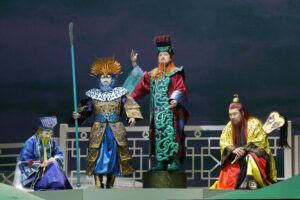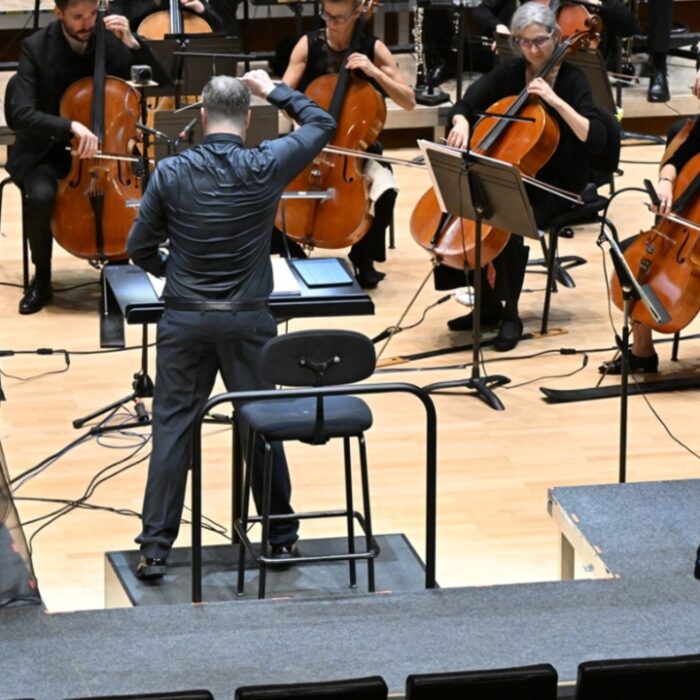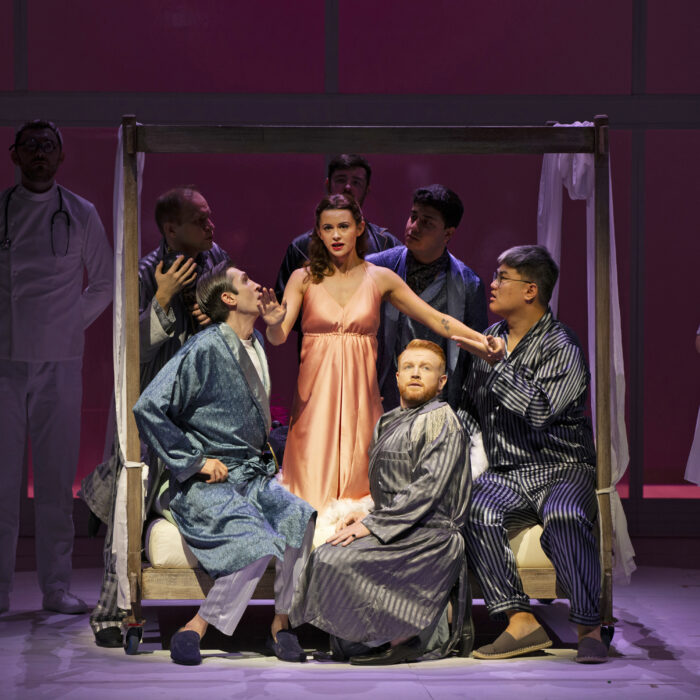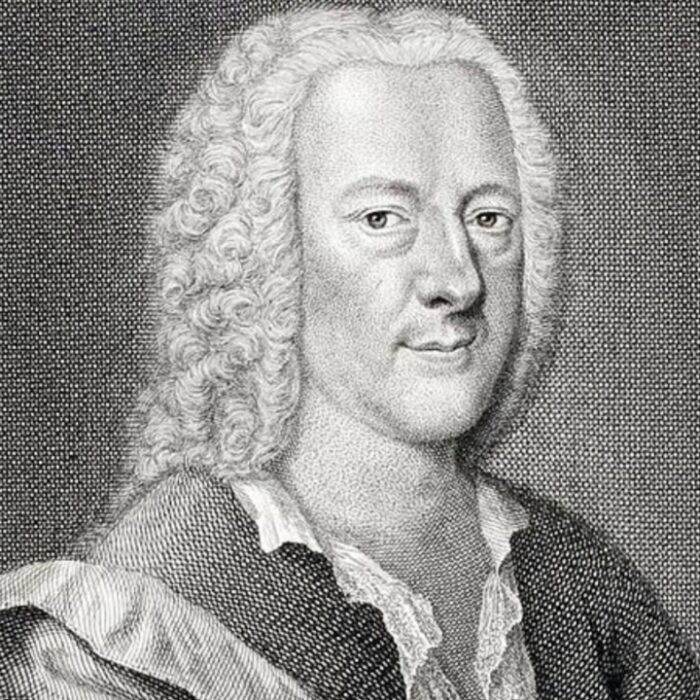
San Francisco Opera 2025-26 Review: The Monkey King
World Premiere Fills the Hall With High-Flying Entertainment
By Lois SilversteinThe beloved Chinese hero, Monkey, landed in San Francisco Friday night, complete with an entourage of dancers, singers, acrobats, and antics that came from an ancient story revisited, along with video-games and comics, among others. In the Lobby, before the performance, a group of young drummers from Grant High School, Sacramento and dancers from the Chinese American International School with drums, gongs, and bells, performed to bring us right into the field of Chinese performance art. It was more than dynamic; it established the world we were about to enter.
From opening curtains to closing, the opera house remained electrified with sound, color, movement, and spectacle. Guan-Yin appeared as both a moving icon and singing in almost every scene; Monkey appeared in triplicate: as himself, in many times and spaces, as dancer and acrobat, and as puppet. Music filled every moment and came from a fifty-one piece orchestra including pipa, multiple percussion instruments, Indonesian gongs, a Chinese opera gong, and small Chinese crash cymbals. Solo voices of course were the mainstay, plus a full chorus and an array of dynamic projections throughout. It was a non-stop interpretation of centuries’ old story-telling from the first seven chapters of “Journey to the West” by Wu Cheng’en, including elements of Chinese opera, masks, and puppetry. San Francisco’s production, directed by Diane Paulus, with renown Puppeteer Basil Twist, conducted Carolyn Kuan, and created by composer Huang Ruo and librettist David Henry Hwang was a tour de force.
From the opening descent of Monkey, performed by tenor Kang Wang, making his debut, we were on the watch for invention and informed story-telling. In English and in Mandarin, with Chinese subtitles, he sang with ardor and intensity. He led us to pay attention to the trickster Monkey on multiple levels, beginning with being born from a stone. From then on, he was determined to control everything and became a Superhero with class. Mei Gui Zhang as Guanyin, the guardian of the Sutras, in particular “The Diamond Sutra,” made sure while he is performing what seemed like the inexplicable, he is also being observed and measured by the unmoved mover of the universe. Thus, the question becomes just how meaningful or meaningless Monkey’s actions are. Needless to say, for the purposes of theatrical excitement, Monkey continued his notoriously riotous behavior and outrageous talk. We didn’t seriously wonder how it would or would not work out. The characterization was rather easy and fun to identify with throughout: here was a naughty boy and a human being on the run, to run the world he lives in, while frequently reminded to shape up or else.
Guanyin, known as She Who Hears the Cries of the World, sang most persuasively throughout. However didactic her message for Monkey, she herself was a gorgeous expression of Compassion and the commitment to it. Enclosed in a flying platform for the whole show, she presented both the theory and the example of calm and order all throughout, even as she tracked the antics of the Superhero. Her voice resounded with haunting lyricism as she transmitted the passages of “The Diamond Sutra” Hwang and Ruo incorporated in the libretto and score. This added another very moving dimension to the more raucous antics of the production. Her voice came as a welcome lyricism in the midst of the great commotion and hi-jinx on the stage. Mei Gui Zhang previously performed as Dai Yu in “Dream of the Red Chamber”as well as “Un Ballo in Maschera” and Gluck’s, “Orpheus and Eurydice.”
How did these passages fuse with the narrative? Over-all quite well, but sometimes they felt like lovely and lonely stand-alone pieces. It was tempting just to stop and contemplate all she aimed to transmit. The Chinese titles were available for those who were fluent in the Chinese language; for those of us who were not, the pure sound of her voice gave us a sense of hanging jewels, almost jeweled ideals, that were more than relevant to the tale but were not yet integrated by the young/old hero. Only when he would become ready or in any way interested in them, would they influence him. He too is a Parsifal. Further, the iconic leaf in which she “rode” around, while appropriate to the Buddhist iconography, at moments kept her more isolated than she might have been without it. The sharp edge while graphically perfect kept her in her container whereas it might have been more effective if she did not inhabit another “universe.”
Monkey #2, was performed by the dancer/acrobat Huiwang Zhang, making his debut. He was charming and graceful, supple and thoroughly accented the development of the Monkey character. The dimension of movement heightened the playfulness and the joie de vivre of Monkey and helped to give him even more energy that he already had. What a fine idea.
The puppet added another dimension, plus something of the piquant and the pleasant to the rich array already conveyed. This Monkey, #3, seemed charming but not nearly as vital as Monkey #2 and of course Monkey #1.
Master Subhuti was sung by South Korean Baritone Jusung Gabriel Park who also made his San Francisco Opera debut. He was revealed to be the Buddha. The Jade Emperor was performed by South Korean tenor Konu Kim, who had previously performed as Bao Yu in “Dream of the Red Chamber” in 2022. Dragon King Ao Guang was performed by Joo Won Kang, who also performed Lord Erlang. Supreme Sage Laojun was played by Peixin Chen, who sang Sparafucile in the season’s “Rigoletto.” Each singer contributed substantively to the richness of the tapestry unfolding on the stage.
The Chorus, under the guidance of John Keene, appeared and reappeared in various guises and roles throughout. They looked good, they sang with energy and clarity and they indeed served the purpose of community energy and attitude that befit the story. Just as the function of the Chorus in Greek Theater, and perhaps in Chinese Opera, the chorus provided multiple layers of commentary on the unfolding action as well as a human dimension as the tale unfolded.
The production itself was extraordinary. Puppetry Director Basil Twist, Choreographer Ann Yee, and Associate Set Designer Sara C. Walsh, worked to integrate the many art forms to serve the story’s multiple artistic aims. In so many ways, it was Wagner’s Gesamtkunstwerk in action. Under Lighting Designer Ayumu “Poe” Saegusa the stage was awash with a constant stream of changing brightness and color that left one mesmerized. So too the projections by Hana S. Kim, a carefully chosen array, amplified the already brilliant displays of the narrative events. Peking Opera Specialist Jamie Guan made sure the choices fulfilled the traditions of the opera. Time and space kept shifting with the help of moving silk ribbons floating and flowing across, under and through the scenic dimensions that remained relatively stable. They curled around the stage to fit with the narrative sequences, rising and falling with a frequency that contributed to the moving spectacle of time and space. Contrast remained prevalent throughout, including ice scenes and underwater moments with jellyfish: it was definitely sharp edges be gone. While the story derived from an old tale, five centuries old, it was based on a story that was much, much older. Some of the images, in fact, appear in Buddhist cave paintings along the Silk Road as early as the 12th century. The experience of the opera was, in addition, a non-temporal one, the eternal present animating all that unfolded on stage. In fact, when the opera ended, it could easily have seemed like the beginning.
If anything, the experience of being under their skillful hands shifted any static notions of time and space we might have carried into the theater. Such shifts altered our very understanding of where we were and why. It was a beautiful marriage of story and philosophy.
The costumes, of course, heightened this awareness. Brilliant design, color, fastidious selection of materials and decoration of the most original kind, created by Anita Yavich, took our breath away. The gorgeousness emphasized the imaginative and the mythological quality. The lack of realism heightened the otherworldly perspective. The makeup was outstanding. Masks and makeup highlighted the sheer poetry of what we witnessed
. It wasn’t just décor either; it was a dynamic contribution to the multiple levels on which the opera aimed to communicate. The visual spectacle heightened the playfulness of the story and the magic of the message.
What a debut! What possibility. Opera came to life in new and ancient ways. Bravissimo all around!


